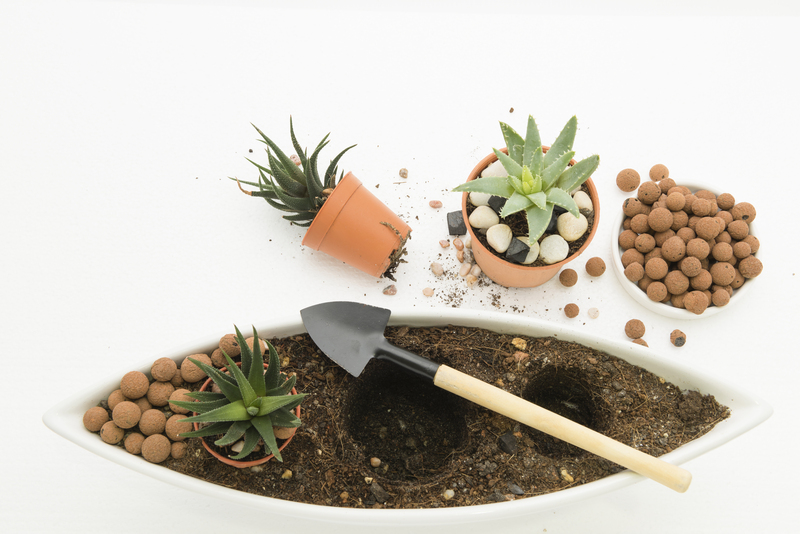Low-Maintenance Garden Strategies on a Tight Budget
Posted on 27/05/2025
Low-Maintenance Garden Strategies on a Tight Budget
Dreaming of a vibrant, serene outdoor space but worried about time, energy, and finances? Creating a low-maintenance garden on a tight budget is absolutely achievable. With the right techniques, the perfect plant selection, and a few creative strategies, you can cultivate a stunning landscape that is easy on both your wallet and your schedule.
Why Choose a Low-Maintenance Garden?
- Time-saving: Spend less time on upkeep and more on enjoyment.
- Cost-effective: Reduce the need for expensive tools, fertilizers, and water.
- Sustainable: Use native plants and eco-friendly practices to support wildlife and the environment.
- Stress-free: Avoid ongoing chores and enjoy the rewards of a thriving garden.

Understanding the Basics: What Makes a Garden Low-Maintenance?
Low-maintenance gardening is all about smart planning and strategic choices. The goal is to minimize ongoing tasks like watering, weeding, mowing, and pruning without sacrificing the beauty and function of your space. Below, we'll break down time-tested techniques and offer plenty of pragmatic, budget-conscious ideas to get you started.
1. Site Assessment: Start with What You Have
- Study Your Soil: Test your soil to understand its type and fertility. Use free DIY methods (like the jar soil test) to determine if amendments are needed.
- Evaluate Sun and Shade: Identify areas of full sun, partial shade, and deep shade. This will help guide your plant selection and placement.
- Check Drainage: After rainfall, notice which spots stay wet or dry out quickly. Use this info to avoid costly mistakes and wasted effort.
Pro Tip: Work with, not against, your natural landscape for the lowest possible upkeep.
2. Choose the Right Plants for Minimal Care and Cost
The backbone of any low-maintenance landscape is plant choice. Opt for varieties known for resilience and minimal fuss. Here's how:
-
Native Plants: These thrive with the rainfall, pests, and temperatures of your region. They require less watering and rarely need fertilizing. Examples include:
- Black-eyed Susan (Rudbeckia)
- Lavender
- Salvia
- Baptisia
- Yarrow
- Perennials Over Annuals: Perennials return each year, saving you money and time spent replanting. Many self-seed or spread to fill gaps naturally.
- Groundcovers and Ornamental Grasses: Eliminate mowing and suppress weeds with tough, low-growing groundcovers (like creeping thyme or vinca minor), or drought-tolerant grasses (like blue fescue).
- Drought-Tolerant Varieties: Species like sedum, agastache, and echinacea flourish with minimal watering.
Planning and Planting Strategies for the Frugal Gardener
Detailed planning is crucial for both success and savings. Here are step-by-step low-maintenance garden ideas on a budget:
3. Design Simplicity: Less is More
- Limit Lawn: Lawns are expensive and time-intensive. Replace grass with mulched beds, groundcovers, or decorative gravel.
- Group Plants Wisely: Place plants with similar water, sun, and soil needs together. This makes care more efficient and reduces water waste.
- Focus on Fewer Species: Using multiples of the same plant creates cohesion and streamlines maintenance.
4. DIY Mulch and Composting
- Free or Cheap Mulch: Wood chips from city maintenance crews, autumn leaves, grass clippings, and even cardboard can become an effective weed barrier and soil insulator.
- Composting: Turn kitchen waste into nutrient-rich plant food. A DIY bin can be made from salvaged pallets, buckets, or old trash cans.
- Mulch Heavily: A thick layer of mulch (at least 3 inches) suppresses weeds, conserves water, and improves soil health.
5. Prioritize Low-Cost, Low-Effort Solutions
- Seed Swapping: Join local gardening groups or online communities to exchange seeds and cuttings for free.
- Upcycle Materials: Use old bricks, stones, or even broken pots for garden edging, stepping stones, or markers instead of buying new.
- Container Gardening: Fill repurposed buckets or crates with plants that don't spread aggressively, making control and maintenance a breeze.
Practical Watering and Irrigation Hacks
Watering can be the most costly and time-intensive aspect of garden care. Try these water-wise methods for an easy and budget-friendly landscape:
6. Water-Saving Garden Tips
- Rainwater Harvesting: Collect rainwater in barrels or buckets to use on dry days. Many municipalities even offer rain barrels at a discount.
- Soaker Hoses and Drip Irrigation: These targeted methods deliver water directly to the base of plants, reducing waste. Hose kits are affordable and easy to install.
- Water at Dawn or Dusk: This minimizes evaporation and ensures roots absorb moisture efficiently.
- Shade and Shelter: Provide windbreaks and partial shade to plantings, reducing their need for frequent watering.
7. Xeriscaping: The Ultimate Low-Maintenance Solution
Xeriscaping is the art of gardening with very little supplemental water. Popular in arid regions, its core ideas are useful everywhere. Key elements include:
- Maximizing Drought-Resistant Plants: Use slow-growing varieties and succulents to create beauty with less water.
- Laying Gravel or Rock: Rock gardens suppress weeds, retain moisture, and boost visual impact with minimal cost.
Tip: Even a small gravel path or mulched zone can reduce the overall work your garden demands!
Weed and Pest Control on a Shoestring
Rely less on chemicals and more on smart prevention plus a few home remedies for pest- and weed-resistant low-maintenance gardens:
8. Weed Suppression Techniques
- Smother with Mulch: Thick mulch blocks sunlight, starving weeds before they emerge.
- Groundcovers: Dense plants like creeping Jenny or sedum act as a living mulch, keeping weeds at bay.
- Manual Weeding: Remove weeds by hand early. Stay ahead with a few minutes a week rather than hours later in the season.
- Homemade Weed Sprays: Use household vinegar or boiling water for spot treatment (be cautious near desired plants).
9. Natural, Budget-Friendly Pest Control
- Encourage Beneficial Insects: Ladybugs, lacewings, and spiders feast on garden pests. Grow pollen-rich flowers to attract them.
- Companion Planting: Garlic, marigold, and chives deter many insects. Interplant them throughout your beds.
- DIY Barriers: Crushed eggshells or diatomaceous earth form a line that discourages slugs and soft-bodied insects.
- Physical Removal: Check under leaves for pests and pick them off. It's free, effective, and safe.
Budget Garden Feature Ideas for Relaxation and Appeal
A beautiful low-care landscape doesn't have to break the bank. In fact, many budget low-maintenance garden projects add value and charm:
- DIY Pathways: Lay stepping stones or recycled wood slices through planting beds to reduce compaction and add structure.
- Simple Seating Areas: Use a salvaged bench or a few tree stumps for rustic outdoor seating.
- Vertical Gardening: Trellis old ladders or pallets for climbing vines--great for small yards and easy to maintain.
- Birdbaths and Pollinator Hotels: Upcycle old bowls or cans as water features, and drill holes into logs for bee habitats.
Seasonal Care: Keeping Chores Minimal All Year
With the right strategies, each season only requires a few key low-maintenance garden tasks:
Spring
- Top up mulch to suppress new weed growth and lock in moisture.
- Divide and transplant perennials.
- Starting seeds indoors or out for best savings.
Summer
- Harvest rainwater and check soaker hoses for efficiency.
- Deadhead flowers to encourage longer blooming with less replanting.
- Keep weeds at bay with quick, regular checks.
Autumn
- Collect free mulch--fallen leaves and cut grass are invaluable for soil health.
- Save seeds from annuals and perennials for next year's planting.
- Store or insulate pots to prevent winter damage.
Winter
- Sharpen and repair tools (do it yourself for big savings!).
- Plan new projects based on what thrived and what needed too much effort last season.
- Order free or discounted seeds from catalogs or swaps.
Common Myths About Low-Maintenance, Budget Gardening
- Myth #1: You need to spend a lot to achieve a lasting, hardy garden.
Truth: With smart plant choices and DIY projects, you can create a stunning garden for less. - Myth #2: Low-maintenance gardens look dull or boring.
Truth: Perennials, ornamental grasses, and creative mulching can be both practical and beautiful. - Myth #3: Native or drought-tolerant plants are hard to find.
Truth: Most local nurseries and garden clubs offer affordable options, and you can often propagate from friends' gardens.

Frequently Asked Questions About Budget-Friendly, Easy-Care Gardening
What are the top three lowest-maintenance plants for beginners?
- Hosta: Thrives in shade, spreads naturally, and needs minimal care.
- Sedum: Extremely drought-tolerant, tolerant of neglect, and spreads attractively.
- Black-eyed Susan: Native, pest-resistant, and blooms for a long season.
How can I make my garden almost weed-free without chemicals?
- Use thick mulch and groundcovers as living mulch layers.
- Install landscape fabric under gravel or rock features.
- Weed early in the season for the biggest impact all summer long.
How do I landscape my yard cheaply?
- Start from seed, swap with friends, and use cuttings for quick, affordable expansion.
- Upcycle materials for garden paths, features, and edging.
- Focus on native and tough perennials--no need for constant replacements.
Conclusion: Beautiful, Affordable, and Effortless!
Embracing low-maintenance garden strategies on a tight budget will not only save money and time--it will enrich your connection to the natural world and create a landscape that's truly yours. By choosing smart plants, reusing materials, and practicing soil and water stewardship, your garden will reward you season after season, with very little ongoing effort or expense. Remember: gardening should be joyful, not burdensome. With the tips above, your low-maintenance dream garden is closer, cheaper, and easier than you ever imagined!



